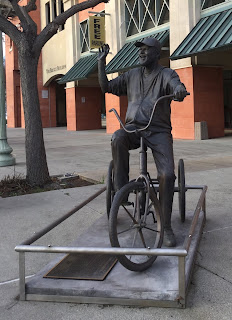My route between the Carnegies in Hollister and Clovis took me over the 1,368 foot Pacheco Pass and past the mystical San Luis Reservoir, the largest off-stream reservoir in the US. It contains one-fifth of California’s water supply. With all the rain of the past weeks it is rising one foot per week and is at 97.5 per cent of its capacity. Last spring it peaked out at 90 per cent. A woman at the visitor center overlooking the reservoir said the residents of San Diego and Los Angeles have to be very happy that they won’t be facing water restrictions this summer.
The visitor center had several rooms of displays and videos explaining California’s vast State Water Project (SWP), by far the largest in the US. It is considered one of the outstanding engineering achievements of the 20th century. It includes over 700 miles of canals and pipelines transporting water from dams and reservoirs all over the state. All the water in the San Luis Reservoir arrives by canal.
A three-and-a-half mile long, three hundred foot high dam retains the water, forming a nine mile long and five mile wide lake. Dams have a strong foothold in California. In a state with few billboards (I have yet to come upon a single anti-abortion one in 1,500 miles, a regular occurrence elsewhere) a rancher beyond the dam had erected a billboard pronouncing “California’s future depends on water. Build more dams now.”
One of the videos at the visitor center showed the ground-breaking for the San Luis dam in 1962 attended by hundreds to hear President Kennedy and Governor Brown, the elder, speak for this joint federal/state project. It took five years to complete the dam and then two years to fill it. In drought years, it can nearly be emptied. It has only been at capacity a handful of years. Among other water issues that impacts Californians an exhibit on flooding placed a lot of blame on forest fires, as they fuse the ground, turning it into a solid mass, preventing the rain from soaking in.
There are four campsites around the reservoir. I didn’t time my ride to be able to take advantage of them. Instead I camped twenty-five miles before the reservoir behind a fenced in yard of construction material shielded from the nearby bustling highway by a port-a-potty, one of several scattered outside the fence for rental. It was a desperation campsite along a long stretch of flat land awaiting planting.
I spent my next night in an abandoned farmhouse that was unlocked and covered with graffiti. At first I thought I’d camp behind it, but since it was open and rubbish-free, other than a lone mini-plastic vodka bottle, I spared myself the time and effort to put up my tent. I still had to unroll it for a little more cushion on the concrete floor than my greatly compressed camp-chair/sleeping pad could provide. It’s adequate on the ground, but not on hard surfaces. I was glad to be indoors when the during the night a gusting wind began rattling the house and brought more rain. The rain was gone in the morning, but not the wind, and it was from the wrong direction.
I’d had only one Carnegie the day before, in Hollister, and only one within range this day, in Clovis. The Hollister Carnegie was in tip-top shape as the City Hall, bright white stone and rebranded with “City Hall” where “Library” had once been over the doorway between two inset columns. It was plaque-free, though the town was not adverse to plaques, as there was one two blocks away accompanying the sculpture of an older guy on a tricycle
The plaque identified him as the beloved local Eric Tognazzini, who died in 2011 at the age of 65. The plaque explained he “overcame the burden of physical disabilities with his outgoing personality and positive attitude towards life. Through this memorial, Eric’s smile and wave will forever touch and inspire the lives and hearts of the people of San Bento County.” Californians honor their eccentrics, as I had seen in Nevada City with the framed photo in its library of a 97-year old who wandered the town and was known by all.
It was 120 miles to the next Carnegie in Clovis, almost twice as far as I’ve had to ride between Carnegies on this trip. The long ride didn’t reward me with anything of note. The building could have been mistaken for a residence other than the canopy over its entrance identifying it as the Chamber of Commerce, and an auxiliary one at that. Clovis, on the outskirts of Fresno, had a population of just one thousand when the Carnegie was built in 1915.
It had a strong case of Californianitis growing to 100,000 and had a pair of Chamber of Commerces to promote itself. The town couldn’t decide on a moniker. A sign in front of the old Carnegie adorned with a horse on it was accompanied by “Business is Good” and “Clovis—A Way of Life.” A banner across its main street called itself “The Gateway to the Sierras.” If I had to come up with a phrase summing up the state, at this point it would be “Too Many Cars, Not Enough Bicycles.”
A trio of Carnegies await me south of Clovis before another long transfer back towards the coast. Then I can brace myself for an incursion into sprawling Los Angeles and eleven more in its environs. That will nearly wrap up my harvest with just two beyond down along the Mexico border.





No comments:
Post a Comment